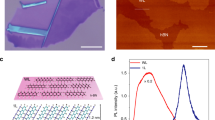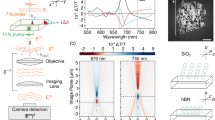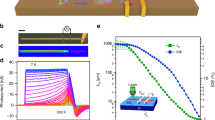Abstract
Excitons in polycrystalline and disordered films of organic semiconductors have been shown to diffuse over distances of 10–50 nm. Here, using polarization- and wavelength-dependent photoconductivity in the highly ordered organic semiconductor rubrene, we show that the diffusion of triplet excitons in this material occurs over macroscopic distances (2–8 μm), comparable to the light absorption length. Dissociation of these excitons at the surface of the crystal is found to be the main source of photoconductivity in rubrene. In addition, we observe strong photoluminescence quenching and a simultaneous enhancement of photoconductivity when the crystal surface is functionalized with exciton splitters. In combination with time-resolved measurements, these observations strongly suggest that long-lived triplet excitons are indeed generated in molecular crystals by fission of singlets, and these triplets provide a significant contribution to the surface photocurrent generated in organic materials. Our findings indicate that the exciton diffusion bottleneck is not an intrinsic limitation of organic semiconductors.
This is a preview of subscription content, access via your institution
Access options
Subscribe to this journal
Receive 12 print issues and online access
$259.00 per year
only $21.58 per issue
Buy this article
- Purchase on Springer Link
- Instant access to full article PDF
Prices may be subject to local taxes which are calculated during checkout





Similar content being viewed by others
References
Kippelen, B. & Bredas, J-L. Organic photovoltaics. Energy Environ. Sci. 2, 251–261 (2009).
Mori, T. & Kato, K. Photovoltaic properties of organic thin-film solar cell using various exciton-diffusion blocking materials. J. Photopolymer Sci. Technol. 20, 61–66 (2007).
Peumans, P., Yakimov, A. & Forrest, S. R. Small molecular weight organic thin-film photodetectors and solar cells. J. Appl. Phys. 93, 3693–3723 (2004).
Lunt, R. R., Giebink, N. C., Belak, A. A., Benziger, J. B. & Forrest, S. R. Exciton diffusion lengths of organic semiconductor thin films measured by spectrally resolved photoluminescence quenching. J. Appl. Phys. 105, 053711 (2009).
Yang, L-G., Chen, H-Z. & Wang, M. Optimal film thickness for exciton diffusion length measurement by photocurrent response in organic heterostructures. Thin Solid Films 516, 7701–7707 (2008).
Agranovich, V. M. & Bassani, G. F. (eds) Electronic Excitations in Organic Based Nanostructures 45–47 (Elsevier Academic, 2003).
Bao, Z. & Locklin, J. (eds) Organic Field-Effect Transistors (Taylor & Francis, 2007).
de Boer, R. W. I., Gershenson, M. E., Morpurgo, A. F. & Podzorov, V. Organic single-crystal field-effect transistors. Phys. Status Solidi 201, 1302–1331 (2004).
Gershenson, M. E., Podzorov, V. & Morpurgo, A. F. Colloquium: Electronic transport in single-crystal organic transistors. Rev. Mod. Phys. 78, 973–989 (2006).
Podzorov, V. et al. Intrinsic charge transport on the surface of organic semiconductors. Phys. Rev. Lett. 93, 086602 (2004).
Ghosh, A. K. & Feng, T. Merocyanine organic solar cells. J. Appl. Phys. 49, 5982–5989 (1978).
da Silva Filho, D. A., Kim, E-G. & Bredas, J-L. Transport properties in the rubrene crystal: Electronic coupling and vibrational reorganization energy. Adv. Mater. 17, 1072–1076 (2005).
Reese, C. & Bao, Z. High angular resolution measurement of the anisotropy of charge transport in single crystals. Adv. Mater. 19, 4535–4538 (2007).
Podzorov, V., Pudalov, V. M. & Gershenson, M. E. Light-induced switching in back-gated organic transistors with built-in conduction channel. Appl. Phys. Lett. 85, 6039–6041 (2004).
Podzorov, V., Pudalov, V. M. & Gershenson, M. E. Interaction of organic surfaces with active species in the high-vacuum environment. Appl. Phys. Lett. 87, 093505 (2005).
Hulea, I. N. et al. Tunable Fröhlich polarons in organic single-crystal transistors. Nature Mater. 5, 982–986 (2006).
Cahen, D., Kahn, A. & Umbach, E. Energetics of interfaces between molecules and conductors. Mater. Today 8, 32–41 (July/August, 2005).
Wakabayashi, Y., Takeya, J. & Kimura, T. Sub-Å resolution electron density analysis of the surface of organic rubrene crystal. Phys. Rev. Lett. 104, 066103 (2010).
Nozue, Y. & Goto, T. Picosecond studies of excitonic luminescenceand reabsorption effect in anthracene crystals. J. Phys. Soc. Jpn 58, 1831–1837 (1989).
Sai, N., Tiago, M. L., Chelikowsky, J. R. & Reboredo, F. A. Optical spectra and exchange–correlation effects in molecular crystals. Phys. Rev. B 77, 161306 (2008).
Müller, A. S., Avlasevich, Y. S., Müllen, K. & Bardeen, C. J. Evidence for exciton fission and fusion in a covalently linked tetracene dimer. Chem. Phys. Lett. 421, 518–522 (2006).
Najafov, H., Biaggio, I., Podzorov, V., Calhoun, M. F. & Gershenson, M. E. Primary photoexcitations and the origin of the photocurrent in rubrene single crystals. Phys. Rev. Lett. 96, 056604 (2006).
SudhaDevi, L. et al. Triplet energy transfer in conjugated polymers: Experimental investigation of a weakly disordered compounds. Phys. Rev. B 78, 045210 (2008).
Markov, D. E., Tanase, C., Blom, P. W. M. & Wildeman, J. Simultaneous enhancement of charge transport and exciton diffusion in poly(p-phenylene vinylene) derivatives. Phys. Rev. B 72, 045217 (2005).
Yoo, S., Domercq, B. & Kippelen, B. Efficient thin-film organic solar cells based on pentacene/C60 heterojunctions. Appl. Phys. Lett. 85, 5427–5429 (2004).
Acknowledgements
This work has been financially supported by NSF-DMR-0843985 and the Industrial Technology Research Grant Program 09E51007d (NEDO). We are very grateful to A. Zakhidov, V. M. Agranovich and E. Garfunkel for helpful discussions, and especially grateful to I. Biaggio for fruitful discussions and for access to the time-resolved PL set-up.
Author information
Authors and Affiliations
Contributions
H.N. and V.P. designed and carried out experiment and performed data analysis; B.L. and Q.Z. fabricated samples; L.C.F. provided important input on data analysis and presentation, and V.P. wrote the paper.
Corresponding author
Ethics declarations
Competing interests
The authors declare no competing financial interests.
Supplementary information
Supplementary Information
Supplementary Information (PDF 204 kb)
Rights and permissions
About this article
Cite this article
Najafov, H., Lee, B., Zhou, Q. et al. Observation of long-range exciton diffusion in highly ordered organic semiconductors. Nature Mater 9, 938–943 (2010). https://doi.org/10.1038/nmat2872
Received:
Accepted:
Published:
Issue Date:
DOI: https://doi.org/10.1038/nmat2872
This article is cited by
-
Anisotropic charge trapping in phototransistors unlocks ultrasensitive polarimetry for bionic navigation
Nature Communications (2022)
-
Organic bipolar transistors
Nature (2022)
-
Supramolecular engineering of charge transfer in wide bandgap organic semiconductors with enhanced visible-to-NIR photoresponse
Nature Communications (2021)
-
Long-range exciton diffusion in molecular non-fullerene acceptors
Nature Communications (2020)
-
The actual electronic band structure of a rubrene single crystal
Scientific Reports (2019)



